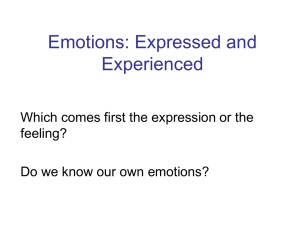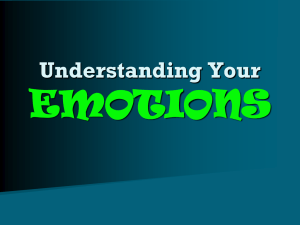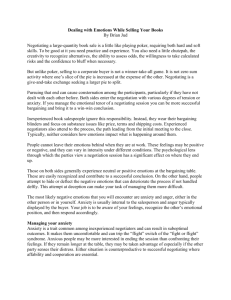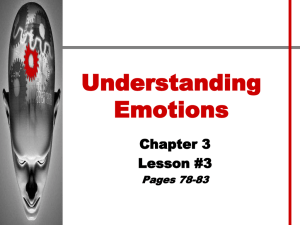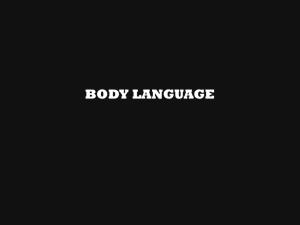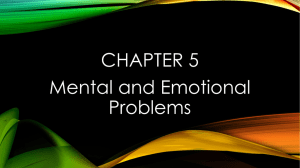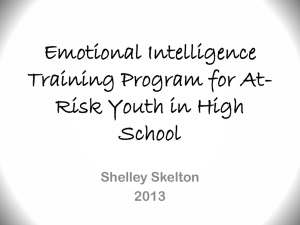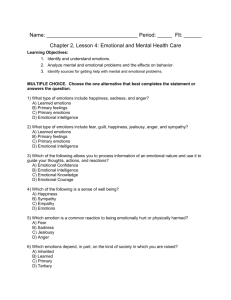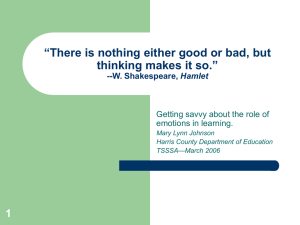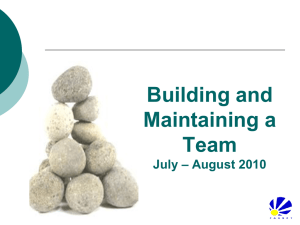Chapter 8 Developing Emotional Intelligence
advertisement
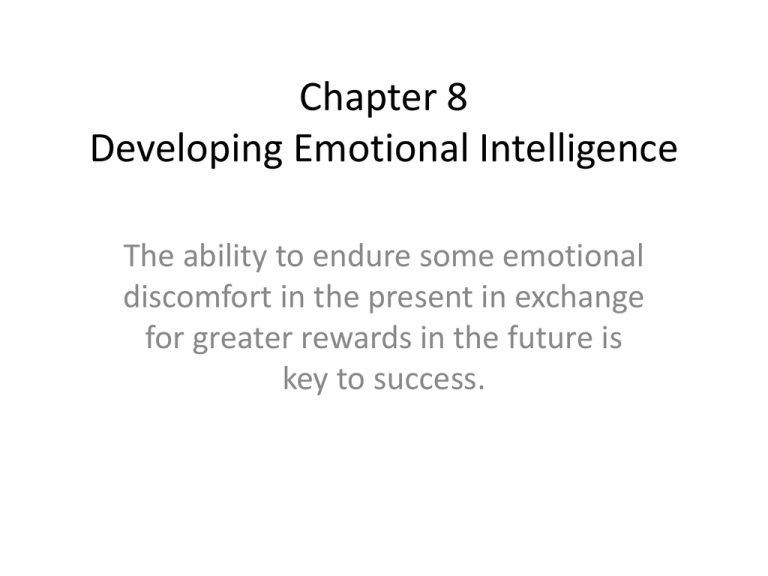
Chapter 8 Developing Emotional Intelligence The ability to endure some emotional discomfort in the present in exchange for greater rewards in the future is key to success. Emotional Intelligence • The ability to manage one’s emotions and stay on course even when navigating life’s most challenging storms. Activity • Complete the following statements: Right now I feel… I feel angry when… I feel afraid when… I feel sad when.. Right now I feel… I feel calm when… I feel peaceful when… If eel contented when… Right now I feel… I feel happy when… I feel joyful when… I feel loved when… Right now I feel… • Now that you have completed the emotional statements attempt to write a poem or song based on the information that you found out about yourself above. Activity • You may hear words that unfamiliar to you. Do not speak at any time during this activity. • “Up on the Roof” • I believe I can fly Marshmallow experiment • Pg. 213 • Emotional intelligence- ability to deal with situations and endure setbacks. This is my definition. • Text offers awareness of our own emotions as they rise and fall. 4 components of emotional intelligence • Daniel Goleman’s 4 components first 2 deal with recognizing and dealing with emotions and the second 2 are social and have to do with recognizing and effectively managing emotions in relationships with others. • Emotional self awareness • Emotional self management • Social awareness • Relationship management Emotional Self Awareness • Knowing your feelings in the moment. • Knowing your feelings as they occur is the foundation of emotional intelligence and it is fundamental to effective decision making. • Those who are aware of their changing moods are able to deal with and cope with their feelings instead of trying to escape them. Having a distraction. Emotional Self Management • Managing strong feelings • Make wise choices despite the pull of powerful emotions. • Wait until you have a clear head to deal with an issue. Do not make a critical decision in the heat of the moment. • Offers delayed benefits in place of instant gratification. Social Awareness • Empathizing accurately with other peoples emotions. Remember active listening. • Empathy is a people skill. People who are empathetic and compassionate are able to read social signals that reveal what other people want or need. Relationship Management • Handling emotions in relationships with skill and harmony. • Must be able to manage the emotions of others. This includes listening, conflict resolutions, cooperation, and articulation the needs of a group. • Resist saying something that publicly embarrasses someone else. How to know your own emotions • Vocabulary of feelings-extensive list • Mindful of emotions as they happen- difference between sadness and happiness • Understand what is causing your emotion-look behind the emotion • Recognize the difference between a feeling and resulting actions-emotions and behaviors are separate experiences, one internal and one external. “My teacher made me so angry that I dropped the class.” • Developing emotional wisdom will help you to be motivated, negotiate emotional storms, and enhance your chances of creating your greatest goals and dreams Reducing Stress Negative stress reducers • Stress is defined as any interference that disturbs a person’s mental or physical well being. • Negative impact on health. • College students negative impact on memory, creativity, concentration, and attention to details. • Do not deal with stress in ways that will haunt you in the future. Spending to much money, eating to much or to little, drugs of any sort. So do not become a victim and blame others or circumstances. Positive stress reduction • Creators manage emotions intelligently by making wiser decisions/choices that release the grip of stress and do not mask it. Take actions to avoid being hijacked by their emotions. • Make a 32 day commitment to be in charge of your life and not the stress. Read about the 4 common types of stress that is the most pressing for you right not. Then choose one of the strategies and commit to it for the 32 days. Then see how you feel. Take one step at a time. This relates to chp. 1 on how to get on course and stay on course. • How to manage the 4 most common types of stress: 1. Overwhelm 2. Anger and resentment 3. Fear and Anxiety 4. Sadness and Depression Overwhelm • • 1. 2. If you feel this often then you have overcommitted yourself. You need to step back, reevaluate, and take action. How to do this by choosing new behaviors: Separate from external factor-get help with children, study late, go to lib. List and prioritize everything you need to do-use next actions list or 6 most important things list, quadrants of what is urgent and important and what is not. 3. Delete unimportant actions where you are wasting time and cross it off of the list 4. Ask for help by delegating some of the A’s and B’s. This frees up time for you. 5. Spend you time doing only A’s and B’s and this will free up more time to finish other needs on your list. Not to mention, you will reduce the overwhelming feeling. 6. Discover time savers-have study cards in the car, cook a large casserole for 2 or three dinners, do all your errands at the same time, have children to help clean up the house, pay teenagers to occupy young children for several hours at a bargain price or take them all to the movies while you do your errands. 7. Say “no” 8. Keep finances organized- curtail unnecessary spending, pay bills on time, use money management strategies, get a debt program 9. Exercise-you know those perky skinny women that are always happy and perky, they exercise a lot and this produces endorphins. Endorphins block pain create a sense of pleasure ( Euphoria) and reduce stress. Choose new thoughts: 1. Elevate- Look at the problem from a bigger picture-Will this problem be important a year from now. Hope the answer is no and move on 2. Trust a positive outcome- Hope for the best and that in the end it will be a blessing 3. Take a mental vacation- Picture a place you love and visualize yourself there for a few minutes. Anger and Resentment • • 1. 2. 3. 4. • 1. 2. 3. 4. When we get angry our brains produce hormones (catecholamine's) that fuel strength and will to fight. Learn your bodies signals of these such as flush skin, heart racing, and tense muscles. Become a creator by pausing and not acting impulsively. Also ask yourself, “ Will I benefit from releasing my anger, or will it cost me dearly?” To avoid being hijacked by your anger and resentment and possibly doing or saying you may later regret try these new strategies by choosing a new behavior: Separate yourself from the problem Exercise Relax Channel anger into positive actions- MADD and Marie Tursi Choose new thoughts that produce calming thoughts: Reframe-Look from a different perspective and through a different set of lenses Distract yourself-shift attention to something positive Identify the hurt- Then express it in some way, learn from it, and move on Forgive-Let the person that hurt you off the hook so that you can get the emotional relief that your deserve. Then forgive them so that you can improve your life. You do not have to forget. Fear and Anxiety • • 1. 2. 3. 4. 5. 6. • 1. 2. 3. 4. 5. 6. Do not let fear and anxiety get out of control by worrying or making an issue bigger than it really is. Test anxiety is common among those in an academic setting and do not let yourself be hijacked by fear and anger of taking a test. Use some of the following: Relax Breathe deeply Prepare thoroughly Bring a piece of home to tests Request accommodations Use visualization techniques Choose new thoughts to soothe irrational anxieties: Detach- then trust the outcome will be a positive one Reframe-”If the worst happens, can I live with it?” Visualize success-Create a mental movie of you being successful by achieving a goal. Assume the best- Always try to put a positive spin on the situation by looking for the best that can happen Face the fear-Just do it- Fear is False Expectation Appearing Real Say your affirmation- Replace negative and fearful thoughts with positive thoughts and language Sadness and Anxiety • • • 1. 2. 3. 4. 5. 6. • 1. 2. 3. 4. 5. 6. 7. Fully grieve a lose of someone or something dear to you. Only way to honor and resolve the lose. Unhealthy sadness is when you feel a dark helpless feeling that polarizes or inhibits your ability to move forward and create positive experiences in your life. Creators pay attention to the signs of depression and try to overcome them by helping their body produce natural, moodelevating hormones the following ways are some suggestions: Do something, anything towards a goal Exercise Listen to uplifting music Laugh Breathe deeply Help others in need To choose new thoughts try the following: Dispute pessimistic beliefs Socialize with friends and loved ones Distract yourself in a positive way Focus on the positive Find opportunity in the problem by learning a lesson Remind yourself that “This too, shall pass.” Just look around and you will see someone who has it worse that you do. Choose your attitude • Do you mange your emotions or do they manage you? • Pg. 223 second paragraph Frankl Creating Flow • • • 1. 2. • 1. 2. 3. Highly enjoyable periods of time are known as flow Csikszentmihalyi states. Flow is also described as the total absorption in what one is doing, by loss of thoughts or concerns about self, and by a distorted sense of time (often passing quickly). He also believes that the key to creating flow is in the interaction between 2 factors: Challenge Skills The challenge a person perceives himself to be facing and the related skills he perceives himself to possess. (Pg. 226 inset box) Boredom=skills higher than the challenge Anxiety=skills are not sufficient to meet the challenge Flow =equal or below Creating flow in college • • 1. 2. 3. 4. 5. How you choose your schedule and classes. Victims choose on convenience while creators choose the best instructor regardless of convenience. Ask which instructors Demonstrate a deep knowledge of their subject Show enthusiasm and value of their subject Set challenging but reasonable learning objectives for their students Offer learning experiences that appeal to diverse learning styles Provides a combination of academic and emotional support that give their students high expectations. Work and flow •


